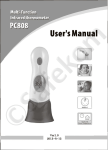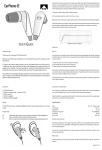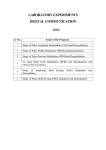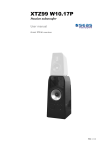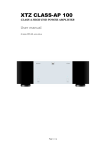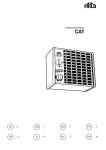Download XTZ SUB AMP1
Transcript
XTZ SUB AMP1 Subwoofer Amplifier User manual © 2009 XTZ AB , www.xtz.se Table of contents Page Contents 3 About XTZ 4 Technical presentation 5 Preparations 5 Practice of sound / Installation and placement tips 6 Mounting and connection tips 8 Functional reference 9 Technical specifications 11 Service & Support 12 - 2- Contents Contents XTZ SUB AMP1 offers some possibilities, so in order to utilize your new loudspeaker in the best way; you should carefully read through this manual before using the loudspeaker for the first time. It may take some patience in order to make the loudspeaker sound optimal. If you have no previous experience of these kinds of installations, or if you have any questions, feel free to contact our free of charge support and we will help you. (See further under the heading of Support on the last page of this manual). - 3- About XTZ Philosophy Our reference and starting point is to recreate a natural sound, but also in respect to the fact that acoustics always is a matter of taste. XTZ Goals Our main goal is to provide the best value for money. Our concept: - Cut down the numbers of middlemen - Put more money on product quality and less on advertising. - Manufacture cost-effective in large volume - Provide perfect technical solutions Contact us Website: www.xtz.se E-mail: [email protected] - 4- Technical presentation SUB AMP 1 works just as good for those who want to power the passive subwoofers (XTZ 99 W10.17P) or any other subwoofers. SUB AMP1 can be perfect as a amplifier for bi-amping for full range speakers By using one or two subwoofers (with correct placement), it is often easier to get a better frequency response. Amplifier The XTZ Sub Amp 1 is equipped with a powerful 300 watt amplifier with a large heat sink for effective cooling. For professional use (studio, PA etc), it is equipped with a balanced input. The terminal connectors are gold plated and very solid. To achieve a high power and a long durability, the amplifier use a large toroidal transformer, large electrolytic capacitors and Toshiba bipolar transistors in the output stage. The active amplifier also provides a variety of adjustment options, not possible to obtain using a passive filter. These include phase, frequency, high pass filtering, volume etc. By using these settings, the main amplifier is relieved and only needs to drive the midrange and treble. This usually results in lower distortion and the risk of damages on it is lowered. Preparations Unpacking Carefully unpack the speaker, and pay attention so you don't break anything. If possible, save the packing box for future transportations. If there should be damage on the loudspeaker, please contact your retailer. Check that the mains voltage marking on the back panel matches your local mains voltage. If the product is cold, wait to connect the power cable till it reaches room temperature. If you don’t do this you can cause damage of the product. Accessories Main power cable User manual Logotype Robber feet - 5- Practice of sound / Installation and placement tips This chapter contains common information on loudspeaker placement and installation. This is general rules, so there are exceptions of some rules In which room do you achieve the best sound? No matter how good the equipment is, in the wrong listening environment it will inevitably sound bad. There are some basic rules concerning a proper loudspeaker installation: Reflections Carpets, curtains and soft furniture absorb mid range and high frequency sound, and this is preferable. Big empty area, on the contrary, reflects it and produces hard reflections that may lead to blurry dialogue. Apart from colouring the sound, also the perspective of the sound will deteriorate. Reflections in the room can roughly be compared to the reflections that yield ghost pictures on a TV screen. Amplification of bass A loudspeaker that is placed near a wall, ceiling or floor will amplify lower frequencies in a sometimes frequencies not desirable way (since it may lead to an indistinct sound recreation). This amplification becomes even more obvious if the loudspeaker is placed near a corner. Thus, for a sound as clear as possible, the loudspeaker should be placed at least 30 cm (about 12 inch) away from the wall Some constructions are made to be placed closed to a wall. Room dimensions Quadratic rooms or rooms where the length is exactly twice as long as the width should be avoided, since they may create unwanted resonance. Furniture Be aware that furniture may vibrate and thus create bad sound at loud bass. Front speakers To get the best result the front speakers should be placed symmetrical in front of the listener. The distance between the front speakers should be around 80% of the distance to the listener. In other words, the recommended angle between the front speakers should be 45° Angling? Either you can have the loudspeakers angled in towards the listener or you can have them directed straight ahead. Some loudspeakers sounds better when angled, but this may also depend on reflections from the side walls. By angling the loudspeakers inwards, you decrease unwanted reflections and thus you get a better stereo perspective. - 6- Placement of the subwoofer The placement of the subwoofer in the room dramatically affects the overall frequency response and sound level of the system. At low frequencies the effect of the room is strong. Even a slight change in the subwoofer's location can make a significant difference in the frequency balance. Patience and experimentation is needed to find the optimal placement. The placement affects the phase difference between the main loudspeakers and the subwoofer. Subwoofers often get a more linear frequency response placed in a corner. The correct height If the loudspeakers are small, they should be placed on stands or tilted so that they are on the same level as the ears. Cables Try to keep them as short as possible. By its electrical parameters, a long conductor will have a bigger influence on the sound than a short one. The subwoofer cable should be shielded, to avoid noise. Make sure that all connections are clean and not oxidised. All connections should be mechanically stable, both power, signal and loudspeaker cables. Signal cables should be separated from other cables. Finally Please remember that good sound is a matter of taste, so you have to experiment to obtain your favourite one. We wish you best of luck! - 7- Mounting and connecting tips Mounting alternatives SUM AMP1 is constructed to be placed lying down Mount the feet on the side you want to be or standing up. Place the logotype in same direction down. as SUB AMP1 Connect using the correct phase Always connect using the correct phase, from the If you by accident connect the other way, +-pole on the amplifier to the +-pole on the there is no risk of damage. However, the sound will not be correct, especially in the loudspeaker and corresponding for minus (-). lower frequencies. Overload With high power load under long time there is risk If you play extremely loud for a long time there is a big risk that you destroy the of overloading the driver and/or the amplifier. product. Load We recommend that no more than 2pcs of 8 Ohms subwoofer should be connected to SUB AMP1. This is because the impedance should be extremely low. - 8- Functional reference XTZ SUB AMP1 Rear panel To obtain the optimal sound, you should let the subwoofer be in ON mode. The amplifier will then immediately have the right working temperature from the beginning. Turn off the subwoofer if it is not in use for along period. Main switch (ON, OFF) Power switch. Press down "I" to power on and the indicator will be lighted. Press "0" to power off. Make sure it is set OFF when connecting / disconnecting cables. There is an automatic switch on the subwoofer. When it has signal in, it will switch on and consequently switch to standby (this is indicated by the LED, which turns blue when standby is present) when no signal is present (after a certain time period).Therefore, you can have it ON constantly. VOLUME Controls volume level of subwoofer. Be gentle on the volume knob; please remember that certain sound signals may containa lot of energy. FREQUENCY Variable control from 40Hz to 250Hz provides (3dB) optimum setting of subwoofer crossover frequency to match crossover frequency of Home Theatre components. EQ 1 Increases 7dB @ 25Hz Excessive use of EQ can lead to damage of the subwoofer, when used at high volumes EQ 2 Increases 7dB @ 50Hz Excessive use of EQ can lead to damage of the subwoofer, when used at high volumes EQ 2 and High Pass filter should not be used at same time. - 9- PHASE 0-180 phase adjustment HIGH PASS Switch ON and the high pass are available. Switch OFF and the high pass are unavailable. BALANCE Balanced input LINE IN Line-level inputs to subwoofer. Use these RCA jacks to connect audio signals from line-level outputs on a receiver, preamplifier, television set or surround sound decoder. If only a mono (single) subwoofer output is provided, connect it to either of input jack. SPEAKER IN Stereo high-level inputs to subwoofer. Use these terminals when line-level connections are not available from receiver, preamplifier or surround sound decoder. AC INPUT Connect to regular 230 V / 50 Hz. OUT (SPEAKER OUT) High Level OUTPUT to speaker/passive subwoofer. Stereo high-level inputs to subwoofer. Use these terminals when line-level connections are not available from receiver, preamplifier or surround sound decoder. - 10- The high pass crossover removes the deepest part of the bass spectra. This is helpful in many rooms, since they heavily amplify the deep bass tones, which may lead to uncontrolled bass. Remark: By connecting both lines in inputs to the same signal, you increase the level by 3 dB. Certain types of simpler low level audio cables may create a noise in the subwoofer. We recommend double shielded low level cables to be used. Technical specifications Construction type Amplifier Class AB Dimensions 376 x 396 x 225 mm (HxBxD) Weight 16 kg/pcs Frequency response 10-250 Hz Connections Gold plated RCA XLR Balanced input Speaker input: Banana plug/Pole screw Speaker output: Banana plug/Pole screw Power amplifier 300 W RMS in 4 ohm 400 W RMS in 2 ohm Connections and settings • • • • • • • Stereo low level input, balanced input and high level (speaker) input. Auto on Phase selector 0 to 180 degrees. Boundary frequency control (40-250Hz) Volume control High pass switch Heavy duty screw terminal connectors - 11- Feet add 22mm Service & support Service If you need service contact your local dealer. You are always welcome to contact us if you have problems with product by e-mail: [email protected] Webpage: www.xtz.se Support Please contact our “free-of-charge” support if you need installation advice, or if any problems occur during the installation. Contact us by e-mail [email protected] and include your phone number if you require help, and we will ring you back. - 12- ALWAYS pack the product / part very carefully. Unfortunately damages during transportation are very common. If the package is weak, the transporting company does not compensate damages. Always enclose a copy of the receipt and a description of the defect.












